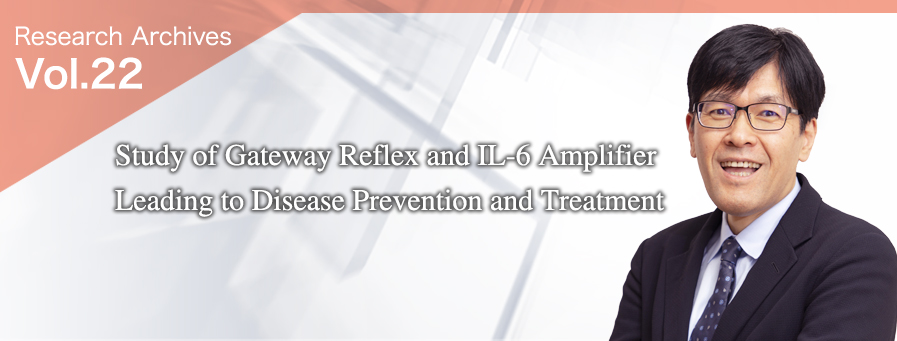
Division of Molecular Psychoimmunology, Graduate School of Medicine, Hokkaido University
Masaaki Murakami, V.M.D., Ph.D.Immunology
- Education
-
- 1989
- V.M.D. Veterinary Medicine, Hokkaido University, Sapporo, Japan
- 1993
- Ph.D. Immunology, Osaka University, Osaka, Japan
- Academic Appointments
-
- 1993-99
- Assistant Professor, Institute of Immunological Science, Hokkaido University, Sapporo, Japan
- 1999-2001
- JST Postdoctoral Fellow for Research Abroad, HHMI, National Jewish Medical and Research Center, Denver, Colorado, The U.S.
- 2001/2002-03
- Visiting Associate Professor, Integrated Department of Immunology, Colorado University, Denver, Colorado, The U.S.
- 2002-07
- Associate Professor, Graduate School of Medicine, Osaka University, Osaka, Japan
- 2007-14
- Associate Professor, Graduate School of Frontier Biosciences, Osaka University, Osaka, Japan
- 2014-present
- Professor, Institute for Genetic Medicine, Graduate School of Medicine, Hokkaido University, Sapporo, Japan
- 2016-present
- Director, Institute for Genetic Medicine, Hokkaido University, Sapporo, Japan
Study of the stress gateway reflex has scientifically proven that illness originates in the mind.
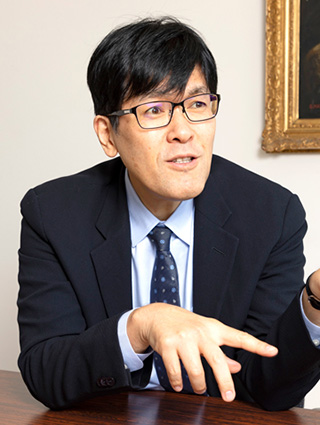 “Organs in the body communicate with each other to function properly. The ultimate purpose of studying inter-organ communications (i.e., the communication mechanism enabling organs to coordinate their functions with one another) is to explore the questions of ‘What are living things?' and ‘What is life?'” Professor Masaaki Murakami, who leads the Division of Molecular Psychoimmunology, continues, “We have been focusing on studying inter-organ communications from the perspective of the neural signal system or regulation by neural circuits.”
“Organs in the body communicate with each other to function properly. The ultimate purpose of studying inter-organ communications (i.e., the communication mechanism enabling organs to coordinate their functions with one another) is to explore the questions of ‘What are living things?' and ‘What is life?'” Professor Masaaki Murakami, who leads the Division of Molecular Psychoimmunology, continues, “We have been focusing on studying inter-organ communications from the perspective of the neural signal system or regulation by neural circuits.”
In the new discipline of studying the neural signal system that regulates immune reactions by specific neural circuits, the research of two reflex systems is well known: the inflammatory reflex and the gateway reflex. It was Professor Murakami who discovered the gateway reflex in 2012. The gateway reflex is a mechanism by which the activation of specific neural circuits induced by gravity, stress or other environmental stimulations alters the condition of specific vessels in the brain, spinal cord or retina, and creates gates to let in autoreactive T cells to those organs where cellular invasion is limited by specific barrier systems.
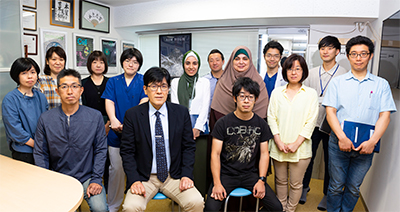
Professor Murakami's research team has discovered that there are five types of gateway reflexes induced by five environmental stimulations—gravity, electricity, pain, stress and light.
“Neural circuits run throughout the body, while autoreactive T cells—which recognize the components of its own body as foreign invaders and attack them—increase in number inside the body due to aging, stress, infection and other factors. The nervous system and the immune system sometimes interact in an undesired manner that may cause disease. The study of the gateway reflex explores various inter-organ communications and pathological conditions caused by inter-organ communication failure from the two perspectives of specific neurovascular communication in response to various types of environmental stimulation and autoreactive T cells in the blood. In the bioelectronic medicine field, a new technology is expected to be developed that will enable the control of diseases and organ functions by artificially regulating the gateway reflex that exists in every part of the body.”
Gravity gateway reflex (gravity-induced gateway reflex), as published by Professor Murakami in the research journal Cell in 2012, is a series of phenomena involving the formation of gates in the endothelial cells in dorsal vessels of the L5 cord induced by gravity stimulation. In 2019, they have been working on joint research with NASA and JAXA to verify the gravity gateway reflex in space, which is free from gravity stimulation, and mouse models of inflammatory diseases are currently being analyzed. “These mouse models were raised for approximately one month in space. As we anticipated, it appears that no inflammation developed in the spinal cord in space. On the other hand, according to an experiment with retina inflammation models conducted to test the hypothesis that visual disturbances specific to astronauts are associated with inflammation, it seems that mice developed retina inflammation in space just as they do on earth. Plans are slated for the results to be summarized in a report.”
The study of the stress gateway reflex has scientifically clarified the mechanism behind the strange phenomenon of diseases originating in the mind; in other words, one's mental attitude can affect the development of a disease and symptoms can either be milder or more severe, something we often experience in this stressful society. Soon after the release of the results of this study in 2017, mass-media at home and abroad rushed to cover this news.
“Stress can trigger the activation of specific neural circuits and cause the gateway reflex in two specific vessels in the brain. If autoreactive T cells, which recognize antigens in the central nervous system, exist in the blood circulation during this process, T cells accumulate in the gateways and microinflammation is induced. It has been discovered that a normally resting neural circuit running through an area of such microinflammation is extraordinarily activated, resulting in digestive tract inflammation, cardiac failure or even sudden death. This research showed that the relationship between psychological stress in modern society and various disorders is dependent on the molecular mechanism stemming from autoreactive T cells and inter-organ communications.”
However, “Some people do not develop disorders even when they are under stress, and we would like to find out the mechanism behind this.” To this end, the identification of particular molecules that serve as markers in autoreactive T cells and specific neural circuits is under way. “Some of the candidate molecular markers have been studied and this research is expected to be completed in a few years. The detection of cells expressing the markers and an activated state may allow us to determine susceptibility to stress-related illness.”
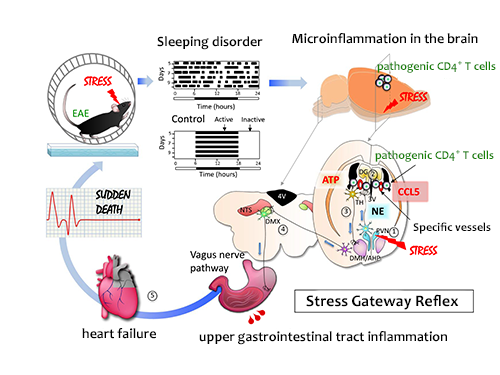
Hoping that new concepts will be discovered through experiments and data accumulation
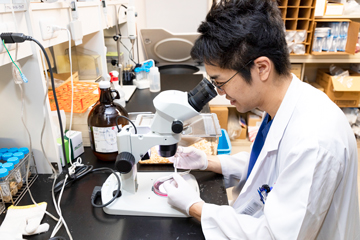
In the region where gateways for immune cells are opened by the gateway reflex, a variety of inflammation-inducing proteins are secreted from activated immune cells, and the IL-6 amplifier (inflammation amplifier)—the molecular mechanism (loop) further reinforcing the production of inflammatory factors—is activated. The IL-6 amplifier closely related to chronic inflammatory disorders was discovered by Professor Murakami while he worked at Osaka University, and this is one of his unique research achievements.
“We have identified over 1,000 genes related to IL-6 amplifier activation and more than 500 molecular groups produced by the IL-6 amplifier. Based on this, some of the molecular mechanisms for chronic inflammation have been clarified. Since it has recently been discovered that many disease-related genes identified from SNPs are related to the IL-6 amplifier, a wide range of human pathological conditions, including organ inflammatory disorders and autoimmune diseases, are being analyzed in collaboration with clinical research laboratories.”
Doctors from Japan and other countries as well as graduate students from unrelated academic backgrounds belonging to Professor Murakami's research team develop their research skills while sharing knowledge and experience. They are determined to achieve the goal of putting basic research experience into clinical practice or taking on the challenge of engaging in a new research field.”
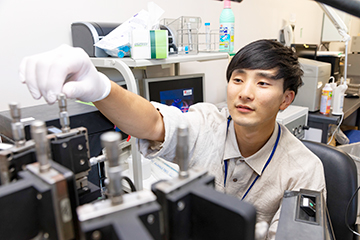
According to Dr. Nobuya Abe, a rheumatologist and graduate student, “It is difficult to perform medical examinations and treat systemic lupus erythematosus, an autoimmune disease, because the pathology in the central nervous system has yet to be fully clarified. Through my experiments, I would like to verify the effects of stress on the neuroimmune system in patients. Studying basic research enables practical physicians to observe clinical medicine from another angle. I now have a broader view when examining patients. For example, I can pay attention to cytokine activities.”
Mr. Nobuhiko Takahashi, who is in his second year of the master's program after completing a science and engineering program at a university in Tokyo, told us, “I instantly decided to study at this graduate school because of the attractive learning atmosphere created by the campus and Professor Murakami.” He is conducting research on two themes, including the mechanism of multiple sclerosis relapse. “I conduct research in a relaxed atmosphere in which members of different ages and from various backgrounds are able to engage in discussions on equal footing.”
Professor Murakami has devoted himself to one experiment after another and as a result has made unique discoveries. He offers the following advice to graduate students, “Keep your experiment even if you make mistakes. Please conduct a number of experiments carefully and thoroughly to collect and accumulate data and many results that are inconsistent with past concepts or your own hypotheses. You should consider yourself lucky if you encounter data that appears to be unexpected. In my opinion, it is important to overturn the conventional sense of value that simply accepts what is written in textbooks.”
(Interviewed in November 2019)
Events ranging from academic to fun activities offered
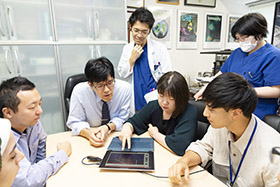
The Journal Club, which introduces the latest articles and meetings to report on the progress of projects by its members, is held every Tuesday. In addition, study meetings with the Department of Molecular Neuroscience, Graduate School of Medicine, Osaka University and joint research and ski trips with the Department of Immunology, Graduate School of Medicine, the University of Tokyo, cake parties, and dinner/lunch parties are held. Thus, the Division offers a variety events that range from academic to fun activities.


